
Guest Blogged by Mewa Singh.
A bit late, but every bit warranted.
Let me begin. I am a HUGE Rabbi Shergill fan. I went to a Dharmendra/Sunny Deol “concert” two years ago (why they are called ‘concerts’ I have no clue) and Rabbi Shergill was performing. I think I was the ONLY 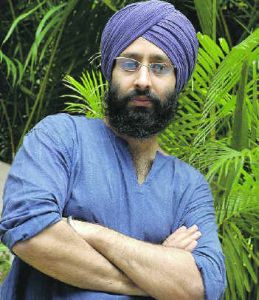 Rabbi Shergill fan in the audience and in certain parts of California that isn’t too surprising. Although my friends and family made fun of me, they were kind compared to the rest of the audience. The audience yelled their ever-so-kind “Eh ki bakwas hai? Bhangra Ga!” (What is this crap? Sing Bhangra!) and began to boo him off the stage in the middle of his ‘Chhalla’ performance. Although I love my hometown, sometimes we are stupid.
Rabbi Shergill fan in the audience and in certain parts of California that isn’t too surprising. Although my friends and family made fun of me, they were kind compared to the rest of the audience. The audience yelled their ever-so-kind “Eh ki bakwas hai? Bhangra Ga!” (What is this crap? Sing Bhangra!) and began to boo him off the stage in the middle of his ‘Chhalla’ performance. Although I love my hometown, sometimes we are stupid.
Rabbi’s first self-titled album played in my car for months straight. Despite the ridicule of all of my friends, I was mesmerized by his brilliance. In my own version of ‘elitism,’ I just thought they couldn’t “understand” Rabbi. How brilliant was this contemporary music artist not only recreating but reinterpreting classic poetic metrics and musical composition forms with current political and social content. While his “Bulla Ke Jana” garnered critical attention and success, for me his “Jugni” with its political content, “Totia Manmotia” for its social charge and reinterpretation of a whimsical Mughal-period popular dialogue between parrots, and the thrilling rendering of his Shiv Kumar Batalvi in “Ishtihar” sent tingles down one’s spine. Sepia Mutiny’s Amardeep criticized Rabbi’s earlier supposed “Sufi/Sikh spiritualist” image, however, such a reading could only be made by one that had never listened past “Bulla Ke Jana.”
Although three years in the making, Rabbi returns with a new album Avengi Ja Nahin (the website includes song samples, videos, and even lyrics). The album has 9 tracks and I have yet to listen to all of them. The cover song “Avengi Ja Nahin” is a nice love song. The other song to gain much attention is his “Biqlis” that provides a voice to the many voices lost during the anti-Muslim government-sponsored pogroms in Gujarat in 2002. The song is stirring, being both patriotic but critical.
Punjabis can argue whether Gurdas Mann’s classic Chhalla from the movie Laung Da Lishkara is the best or Rabbi’s new rendering. For my vote, I just want to add that Rabbi is on the world stage singing Punjabi (in his Jugni invoking that the solution to today’s problems was to invoke the Guru’s name), while during the 1980s and early 1990s Gurdas Mann went to Bombay and record plenty of Hindi content.
However, especially important for a Sikh audience would be a discussion on his song “Pagri Sambhaal Jatta.”
Over the past few years the website Sikhitothemax.com has become one of the premier tools for English-fluent Sikh youth to access their Guru Granth Sahib. While STTM has problems that can be addressed at another time, it is important to realize the effect that this tool has had. 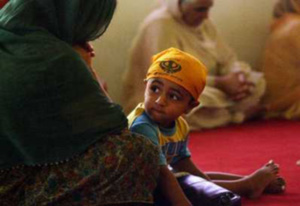 Many Gurdwaras throughout the world have added STTM translations as part of their regular programs and the projection system in the Gurdwara is fast becoming the norm.
Many Gurdwaras throughout the world have added STTM translations as part of their regular programs and the projection system in the Gurdwara is fast becoming the norm.
But is it enough?
In a recent article in the Fresno Bee, reporter Vanessa Colon looks at the question of “losing tradition in translation.”
Colon interviews a number of Central Valley Sikhs and finds that the Sikh youth are often not engaged with their Gurdwara. Although there a number of reasons, she delves into the question of language first and foremost. Some local Fresno Sikhs blamed the Sikh youth for not learning enough Punjabi. However, I see that this approach has problematic for there are now a number of Punjabi/Khalsa schools in California and beyond. However, instruction one day a week for an hour will not ever provide a sufficient language base for one to understand Gurbani.
UPDATE: Although this post is over 5 months old, I thought I would give an update on the current case. It seems The Herald, a Catholic newspaper in Malaysia, has filed a lawsuit against the Malaysian government’s attempt to ban the usage of the word “Allah” by non-Muslims. The Malaysian Gurdwara Council (is this a real organization or a one-man show, can any of our Malaysian readers fill us in as I couldn’t find any information) has added their name to the lawsuit. Again, I revisit the question, can any one religous community claim a monopoly on its religious vocabulary? How about iconography?
———————————————————————————-
The Sikhs have a long, proud, and distinguished history in Malaysia. While Sikh traders began arriving in South East Asia, during the Mughal period, the Sikh numbers markedly increased under British imperialism.  Sikhs were often settled throughout the colonies as police men and later took a lead role in the transportation industry. Their presence and connection to Punjab has been strong throughout the past and the Khalsa Diwan Malaysia took an active role in ratifying and creating the Panthic Sikh Rehat Maryada during the early years of the 20th century. The Sikh Naujawan Sabha Malaysia remains a leading example of a diasporic Sikh organization.
Sikhs were often settled throughout the colonies as police men and later took a lead role in the transportation industry. Their presence and connection to Punjab has been strong throughout the past and the Khalsa Diwan Malaysia took an active role in ratifying and creating the Panthic Sikh Rehat Maryada during the early years of the 20th century. The Sikh Naujawan Sabha Malaysia remains a leading example of a diasporic Sikh organization.
Despite the Sikhs’ prominent standing in Malaysian society and the relatively secular nature of Malaysian Islam, it is of some note that the government recently moved to have the words “Allah” (God), “Kaabah” (Worship center at Mecca), and “Solat” (prayer) banned from non-Muslim literature and speech.
While I would guess Christian evangelism (Christians in Punjab love to call Jesus ‘Satguru’ and have ‘kirtans’ in his praise) was the main target of such legislation or appeasement towards certain political parties and groups, I am not sure what will be the impact for Sikhs due to our community’s unique lingual affinities with Islam.
Recently I was having a conversation with a non-Sikh about names and how you can tell the gender of a Sikh individual just by looking at their name. I told her that there really wasn’t a fool-proof way of doing this since many Sikh names can be used by both men and women. However, I told her, when you see “Kaur” and “Singh” used in the name, you have a better chance of identifying the gender since it tells you if the individual is female or male, respectively. (Just to confuse her, I did mention that Singh is often also used by women). We were later joined in our conversation by another Sikh woman who basically refuted my explanation of Sikh names by telling our non-Sikh acquaintance that in fact, she and a growing number of Sikhs in our community actually don’t use “Kaur” and “Singh” at all in their name. The whole conversation reminded me of another similar discussion I happened to have with a Sikh friend of mine who, having married a non-Sikh, said that she had no intention of using “Kaur” or “Singh” in the names given to her children.
Now, while I realize that these are two unconnected conversations and I am by no means suggesting this is a trend of any sort – I do wonder how common this is and what (if anything) it means for the Panth. If, for example, my friend chooses not to raise her children Sikh, then I feel ike it is less problematic that she does not use “Kaur” and “Singh” in their names. However, it is interesting to me when people who identify themself as Sikh choose to shed this identity. I am aware that a name by itself does not necessarily establish an identity. However, I wholeheartedly believe that having “Kaur” and “Singh” bestowed upon us by our Guru was no small thing and in fact, it does establish an identity for Sikhs. By not continuing to use “Kaur” and “Singh” in the names of Sikhs, how much of our identity is being diluted? I do believe that there are enough Sikhs who are conscious of this. Many young Sikh women, including myself, who use “Kaur” as a last name now intend to keep it as a last name after they get married. This is also a significant step in solidifying one’s identity.
Thoughts on this?
Sorry for my long absence. Expect an explanation post very soon.
Although there is more current news, there are two past due topics that need to be discussed in The Langar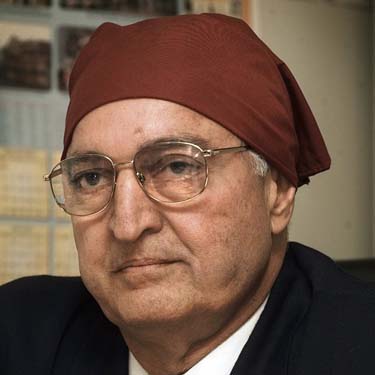 Hall. I begin with the first.
Hall. I begin with the first.
Now while Mack-10’s lyrics in the title of this post may not be completely appropriate, I use them to highlight a possible historic event in the Sikh community in Canada and beyond.
For those of us that grew up in the states, the Dasmesh Darbar of Surrey and the Guru Nanak Sikh Temple of Surrey entered our popular imagination in 1998 when Sikhdom was shaken by the inane “tables and chairs” controversy. A local Surrey conflict soon ballooned throughout the world and even saw violence at a number of different Gurdwaras in North America and Europe. A conflict, which most did not understand, divided local communities and caused rifts that still fester within the Sikh community today.
The worst-affected area was where the controversy initially began – Surrey, Canada. A new vocabulary entered into the language of Sikh-British Columbians: “fundies” verses “moderates.” A generation of Canadian youth saw rishtas broken and dinner conversations centered around “uthay ja thalay” (“up” or “down”).
Few programs exist that provide an in-depth study of Sikhi. Fewer exist in the United States. While there are other ventures, such as the Jakara Movement that attempt to allow entry and inspiration, Sikh Research Institute’s (San Antonio, TX) Sidak provides
distinctive learning program for young adults seeking to increase their commitment towards the Sikh faith. This intensive two-week educational experience is a unique program consisting of instructional seminars on various facets of bani (scripture), tvarikh (history), and rahit (discipline). Sessions on leadership development and community building also serve as key foundations for Sidak. [link]
From Harinder Singh‘s esteemed pedagogy, to various learned guest-speakers, and the culmination in a final project, Sidak is an amazing educational and spiritual experience. This year Sidak is being held on 13 – 26 July, 2008. For more information visit www.sikhri.org

I had a long and interesting conversation with a friend of mine this weekend on different attitudes towards finance and charity between different world religions. We noted that both Judaism and Sikhi require a 10% charitable contribution, in addition to service, which has no upper or lower bound and serves a different purpose. This dovetailed with a conversation I had with a few friends, including one who is an Islamic banker in Dubai, about religious concepts of usury, interest, and charity.
For many low-income and poor communities, asset/wealth creation is a major hurdle, and access to financial/resource markets and services is non-existent. Although Sikhi has strong proscriptions against materialism, greed (moh), and attachment (maya), it also has a redistributive element. While simplicity is embraced, wealth is not necessarily wholly eschewed (if earned honestly and put to just uses).
If a financial institution were opened upon Sikh principles, what would it look like, to you? What kind of services would it offer, or how would it help address the structural exclusion of the poor? For example, I could imagine very low interest or no interest loans, but perhaps other infusions? In other time periods, Sikhs built free clinics and community schools. Khalsa College, on an endowment from one of its funders, still offers free college tuition to local residents (regardless of religion). What are the kinds of “assets,” beyond simply wealth, that could contribute to Sikh principles of economic justice? Do you feel such principles (i.e., economic justice) exist in Sikhi?
Prices go up after Monday. Take a moment at work, take a quick break from your finals, but take it now! A commenter asked to for a meet-up at the conference. A few of the bloggers will be in attendance so come meet a few of the faces behind the nonsense we write! Register now at www.jakara.org
———————————————————————————
From our discussions on dividing Gurdwaras to Green Gurdwaras; from confronting the demons within to forging a new consensus; from questions of grassroots movements to moving beyond generation two blues; all are invited to attend JAKARA 2008 and discuss face-to-face these important issues.
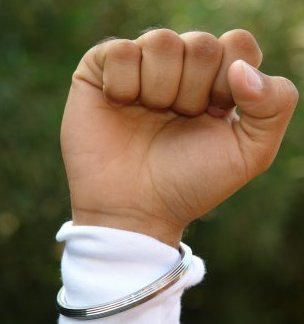 The Jakara Movement Sikh youth conference is only three weeks away with registration closing on June 16th. REGISTER NOW to avoid late fees.
The Jakara Movement Sikh youth conference is only three weeks away with registration closing on June 16th. REGISTER NOW to avoid late fees.
Who: YOU!
What: JAKARA 2008: Growing with our Gurdwara
Where: FRESNO, CA
When: June 19-22, 2008
Why: Because YOU need to be there. Visit the website for more information.
Yes I had urged all to attend in a different post, but consider this a friendly reminder.
Plan to attend, even if you just want to see life beyond bhangra or shoooooooooot, because you just want another Sikh T-shirt (no, you don’t get those ones).
Guest blogged by Mewa Singh
Yesterday’s post by Sundari got me thinking. When I saw the videos of the from the BBC footage from those days in 1984, I began wondering can the Sikh community mobilize like that again? Under what circumstances could it or even should it mass mobilize?
I thought of the mobilization that occurred with the Ram Rahim incident last year. Then while reading the internet news, I came across this Bay Area video.
CLICK HERE TO WATCH VIDEO (sorry the website doesn’t allow me to embed the video)
The media was given the title as the “Spiritual March for World Peace.” Although I have been out of the loop with friends for sometime with my Bay Area friends, what was the ‘real’ reason for the gathering? Was it celebrating the shaheedi of Guru Arjan? Do we really have Nagar Kirtans to remember martyrdoms in our history? Should the march be construed as an anti-war protest? Partially to raise awareness, but partially to learn about the initiative as well, I would love to hear about the background, perspectives, or even your thoughts on this Nagar Kirtan.
While exploring the Sikh blogistan, I came across this link from Sikhswim (Thanks Savraj!) and wanted to share it with the rest of the Langar-ites.
Late last year, November 2007, a Sikh Seattle taxi-driver, Sukhvir Singh was brutally attacked by a drunken Luis Vazquez. Luis had been placed in Sukhvir’s taxi by two police officers, after he had been denied entry into Husky Stadium for public drunkenness and alcohol-induced bellicose behavior.
The story may have ended with the sentencing of Luis Vazquez, but it doesn’t. The story is also about the Sukhvir’s courage, faith, and forgiveness. Sukhvir was the vehicle for Waheguru’s forgiveness. Luis has been given another opportunity. The video is a bit extended, but well worth the watch.
Reflection for Monday by Guru Nanak from SGGS (p. 223) in Raag Gauri:
Khima Gahi Brath Seel Santokh
Extending forgiveness is the (true) fast, (the true act of) kindness, (the true path of) contentment
Usually on Friday, I like to post something musical, something funny, or even something just plain stupid. However, when I saw this news article, I was just so incensed. Yesterday I commented in another discussion that Sikhs need to begin to confront our own Muslimophobia. Another pervasive demon is our prejudice against those of African descent (and yes, dark skin in general).
Apparently at a cricket match at the Mohali Stadium, two black British cheerleaders were asked not to participate by an organizer due to their skin color. The women even allege that the organizer used the ‘n-word.’
Newton told a newspaper: “An organiser pulled us away. He said the people here don’t want to see dark people. The ‘N’ word was used and they said they only wanted beautiful white girls. We were crying. I could understand if it were the crowd, but they were very receptive.”[link]

Many of us have taken part in discussions on how the turban is being commodified and a target for hatred. Understandably there is a strong religious argument for why a turban shouldn’t become another fashion accessory or replaced with a beanie. This argument is anchored in the Sikh meaning of the turban.
The symbolisms of wearing a turban are many from it being regarded as a symbol of sovereignty, dedication, self-respect, courage and piety but the reason all practicing Sikhs wear the turban is just one – out of love and obedience of the wishes of the founders of their faith.
The turban serves as a mark of commitment to the Sikh Gurus. It distinguishes a Sikh as an instrument of the Guru and decrees accountability for certain spiritual and temporal duties. It is a mark of the Guru and declares that the Sikh wearing a turban is a servant of the Divine Presence.
But what happens to this meaning when the turban is being forced upon non-Sikhs? The Cheema Mandi (near Sangrur), Punjab branch of Akal Academy Buru Sahib is requiring all non-Sikh children to wear a patka or dastaar (i.e. type of turban). Most of these children are practicing Hindus who don’t spiritually identify with Sikhi.
I have mentioned Bant Singh before in a previous post, but yesterday while scouring through Youtube I came across a great video of him, his message, and his voice.

To those that may not have heard of him, Bant Singh is from a so-called lower caste background from Pind Jabhar in Zilla Mansa in Punjab. He emerged as a labor activist and became a lead figure in the Mazdoor Mukti Morcha (Laborer’s Liberation Movement).
I just wanted to remind all of you out there, particularly those who live in California, that you can still sign up for the annual Jakara Sikh Youth Conference. The conference is in Fresno, California on the Fresno State campus and the dates for this year are June 19-22, 2008. Don’t be lazy, register and avoid a late fee.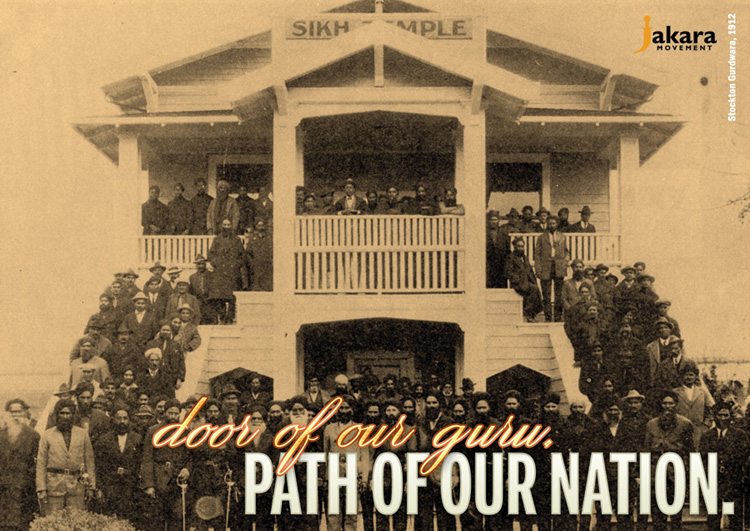
This year’s theme is “Growing with Our Gurdwara.” The introduction from the website are as follows:
They don’t speak our language. They have too much politics.
They are too corrupt.Too few young Sikhs are found at their local Gurdwaras. While young children play outside after Punjabi School and our parents congregate in the langar hall, too many Sikh youth decide not to go to Gurdwara.
However, this does not mean our spiritual thirst has been quenched. It is time for a change. It is time to stop blaming others. It is time for the next generation of Sikhs to empower ourselves and engage with our Gurdwaras. It is time to turn the “they” and “them” into “we” and “us”. The Gurdwara is OUR institution; it will always be the center of Sikh life. It is OUR grassroots democracy if we make it so.
This year at the Jakara Movement Sikh Youth Conference 2008, we will re-create, re-engage, re-emerge with the “door to our Guru”. Join us as we re-kindle our center and grow with our Gurdwara. [link]
A Non-Sikh friend of mine recently asked me about the naming conventions in the Sikh religion. She was wondering why “deep” and “jit” were so common at the end of Sikh names, and did this take away from a person’s individuality. (Like Joe Smith?) I thought it was an interesting point, but personally I don’t feel my name defines me. My uniqueness comes from my personality, the pursuit of my own path and growing through my experiences. Although I do feel I have grown into my name, and it does hold significance for who I am becoming as a human being. What is amazing about our names is the depth of their meanings, the interchangability of parts of the names to create a new meaning, and that they are epicene names. When I do tell Non-Sikhs what my name means, the response is always “Wow, that is so cool!”.
A new pattern emerging these days is the shortening of the name and/or being creative with the way it is spelt. It is inevitable changes will happen as we assimilate to the western world we live in, and with the generational changes that are happening. People used to put faith with the Guru Granth Sahib and the first letter that was chosen, at random, became the starting point for naming a new baby. Is this a tradition that is being utilized today?
We have such an immense choice of names, and I have yet to find a culture that holds deeper meanings for their names, however common they may be, than ours.
I pose this question to you all: What does your name mean to you?
As I was exiting the parking lot of a major grocery store in a heavily concentrated Punjabi area the other day, I saw in my rear-view mirror a woman wearing a salwar-kaamez and holding a Bible with two Indian boys dressed in their “Sunday best” and carrying leather book bags, while they approached a man with a friendly smile. How surprised was I to see a Jehovah’s Witness woman wearing Punjabi clothing while she and these two boys proselytized in this Punjabi-concentrated area.
A few weeks prior, a friend of mine who lives in this same area, shared with me the story of how her family was confused to find a Punjabi couple at their front door delivering the message of God as Jehovah’s Witnesses. She told me that after hearing the door bell she ran to the door and peeped out the window and saw a man wearing a coat-pant and a woman wearing a salwar-kameez. Instantly, she knew they were Jehovah’s Witnesses because of the Bible they were holding and the other paraphernalia in their hands. My friend hollered to her dad that there was an Auntie and Uncle ringing the door-bell, but they looked like Jehovah’s Witnesses so she wasn’t going to answer the door. However, her dad responded rightfully so, “ekaan thaa teekh nahi laghdhaa … ladoo na dhaan ai hon” (that doesn’t look right they might be here to give ladoos).
A Siropa signifies an honor bestowed on a individual for their commitment to Sikhi and their long-term dedication. Lately, however, I am witnessing the increasing distribution of Siropay being “gifted” out based on monetary contribution, or the completion of attendance to an event. Has the true essence of our Siropa tradition disappeared?
Amitabh Bachchan caused controversy last December when he was given Prashad at the Harmandar Sahib, which included a Siropa. This controversy touched upon the ongoing actions of our Gurdwaras of presenting a Siropa for all the wrong reasons. There was value in this tradition when Guru Angad granted Guru Amar Das an honor every year. Guru Amar Das treated these gifts as sacred, and carried them all tied on his head. So when I witness a wedding couple receive a Siropa at Fremont Gurdwara, simply for being married in front of the Guru Granth Sahib, I am confused. The couple was clearly a couple who was openly not interested in Sikhi, so I was disappointed to see this happen at a Gurdwara which draws such a large Sikh community in the Bay Area. This was not the first wedding to happen at this Gurdwara, but it was the first I had witnessed with the giving of Siropay. I wondered, how many Siropay are being given out here each month? I meant to ask the Giani Ji at the Gurdwara why the couple received this honor, but never got the chance. Is this something that is happening at other Gurdwaras?
We are losing the value of this tradition if we continue to “gift” these articles of honor. What will be the difference between a person who has been practicing Sikhi with a true heart their whole life, and a person who plays a Sikh in a Bollywood movie? What will be the difference between a person who has awoken at Amrit Vela every morning to do their Paath for the past 40 years, and a person who attended the Gurdwara and donated a large sum of money?
Whose responsibility is it to decide who deserves a Siropa ? It seems to me that our Gurus left us with these traditions so we could follow them, then why are we making our own rules? As a Sangat should we be adding value to the decisions our Gurdwaras are making?
In one of the rare years in which Vaisakhi falls on April 14th, I wanted to wish everyone a happy Vaisakhi! How did you/your family celebrate? Personally, I totally forgot until reminded by Ms. Phulkari, at which point I coerced my roommate into imitating a dhol while we both danced around. Having settled the cultural side of the day, I’m looking forward to next Sunday’s services.
Hope today found you in good health, and here’s to a fantastic new year!
A fellow blogger (thanks Jodha) sent me a link to an incredible new animated movie to be released across North America in May 2008. Sundri the movie, based on Bhai Vir Singh Ji’s masterpiece (and yes, my namesake), is the third animated Sikh movie released by Vismaad. Many of you may have seen the notable work they did with Sahibzadey and Rise of Khalsa. This movie looks similarly impressive:

The film salutes Sikh women and presents a piece of history which celebrates equality and respect. From the site,
Singhs ought to respect Kaurs.
Kaurs ought to live as true daughters of Guru Gobind Singh ji.“Gender equality” may become a genuine practice than a mere rhetoric.
Right after I graduated college, I moved to semi-rural Kenya. I had heard that there was a historic desi/Sikh population, so I looked for the nearest gurdwara. I found it two hours away on Temple Road in Kisumu, Kenya’s third largest city and the cultural capital of Luo-land.
The Guru Nanak Gurdwara is pleasant with a diverse sangat, but even more exciting was the building across the street — the “Guru Nanak Harambee Dispensary Center.” The dispensary center is as big, if not bigger, than the gurdwara itself. I found it refreshing that the gurdwara not only serves langar each day, but it has devoted equal resources to (re)distributing aid.
It’s hard to give a good translation of “harambee,” but it reflects a community coming together to do good work. If I had to distill it into keywords, I’d pick unity, mobilization, and empowerment. These concepts reminded me of our earlier conversation on daswand. In Kenya, harambee is a means of reaching across differences in wealth, tribal ancestry, gender, and profession. I believe that daswand, paired with seva, attempts to build community in similar ways.
